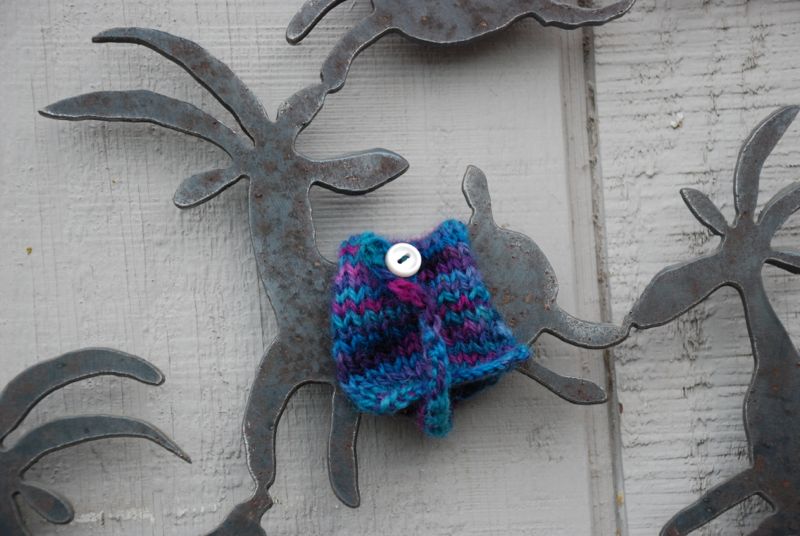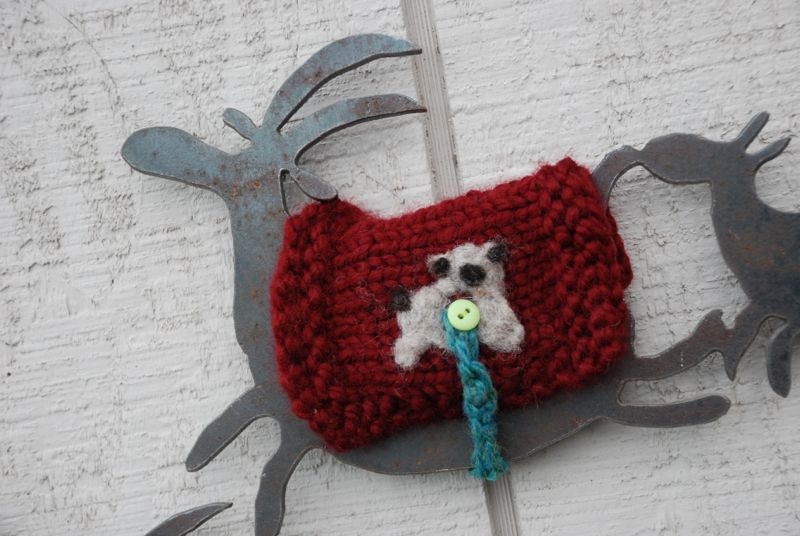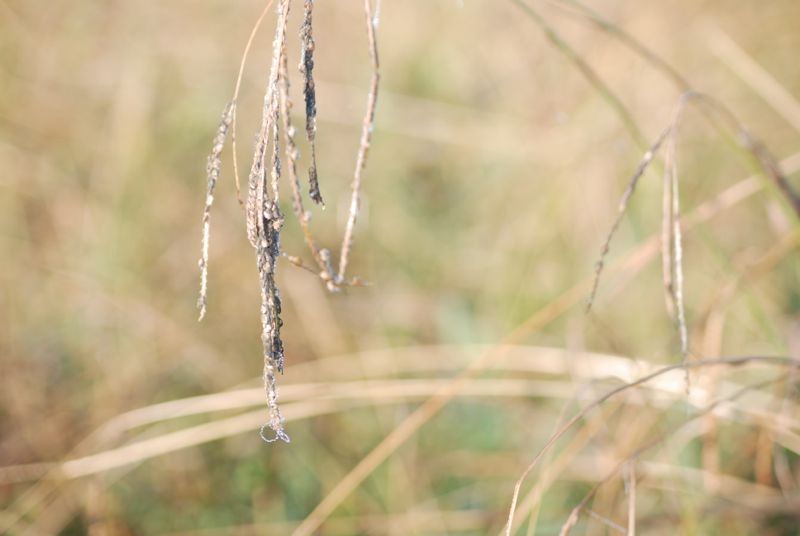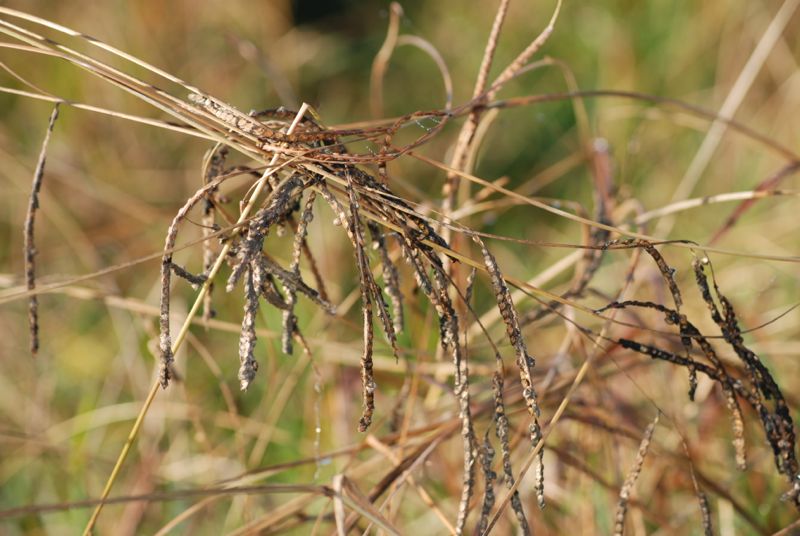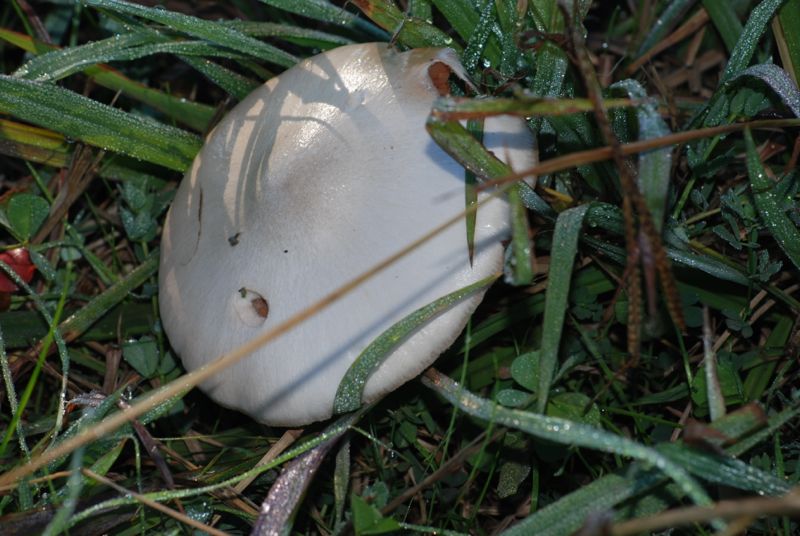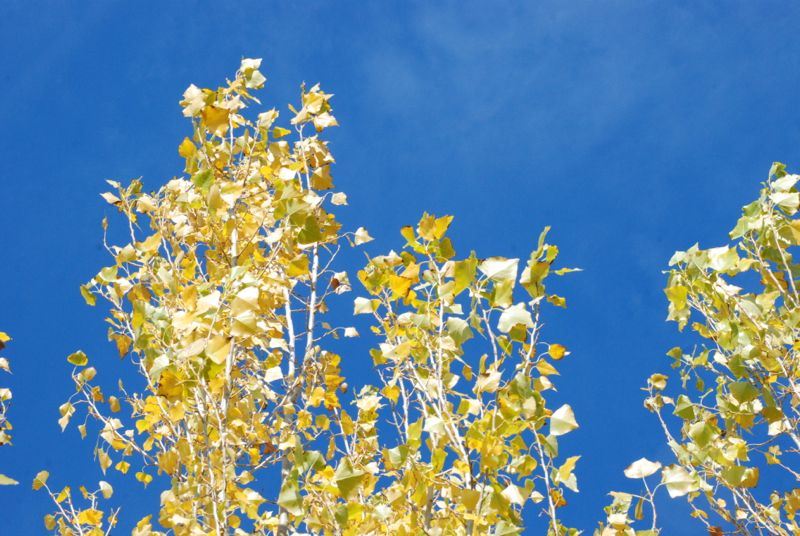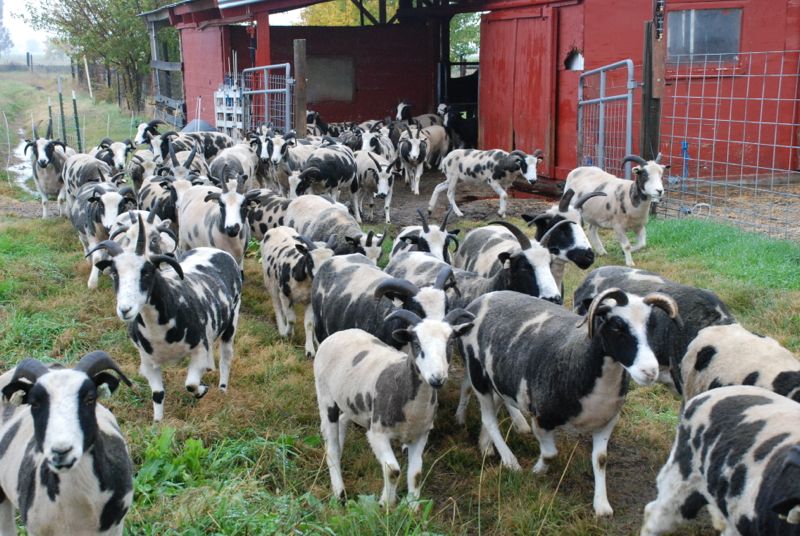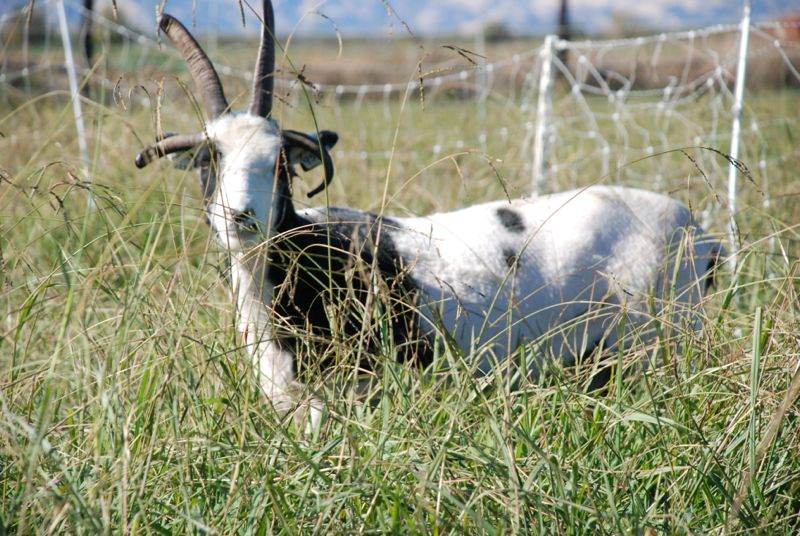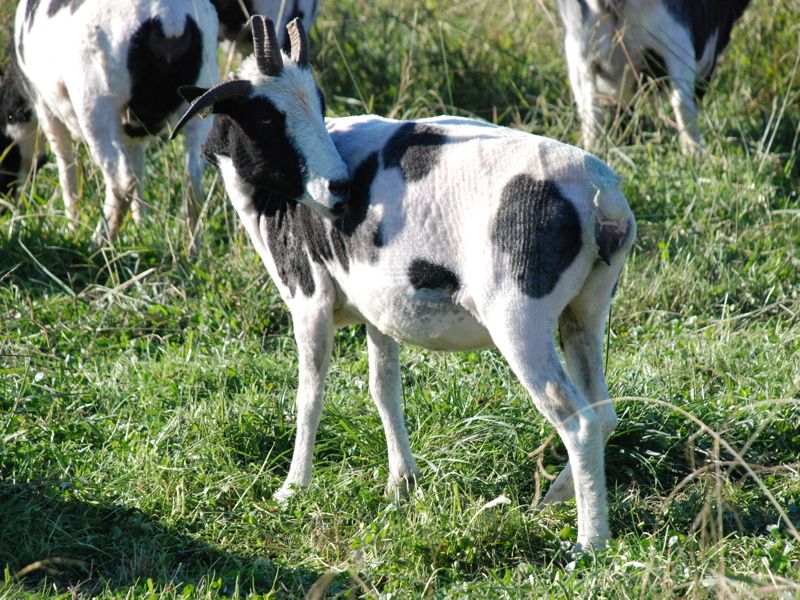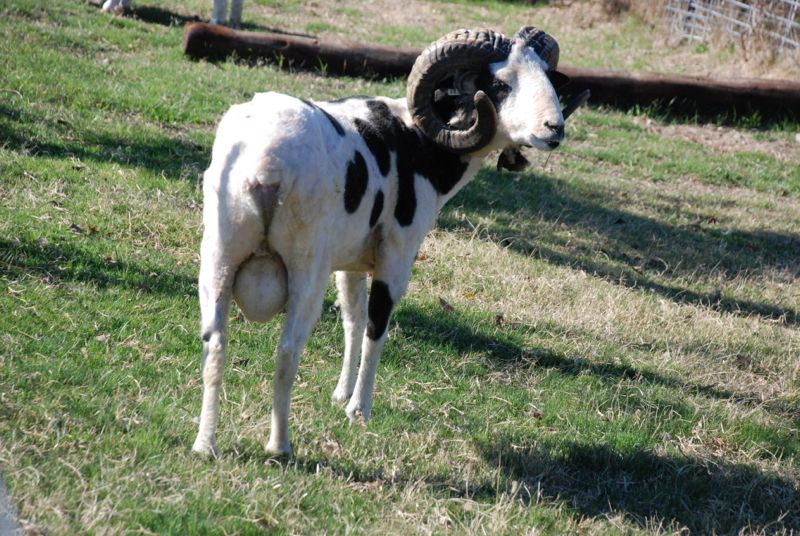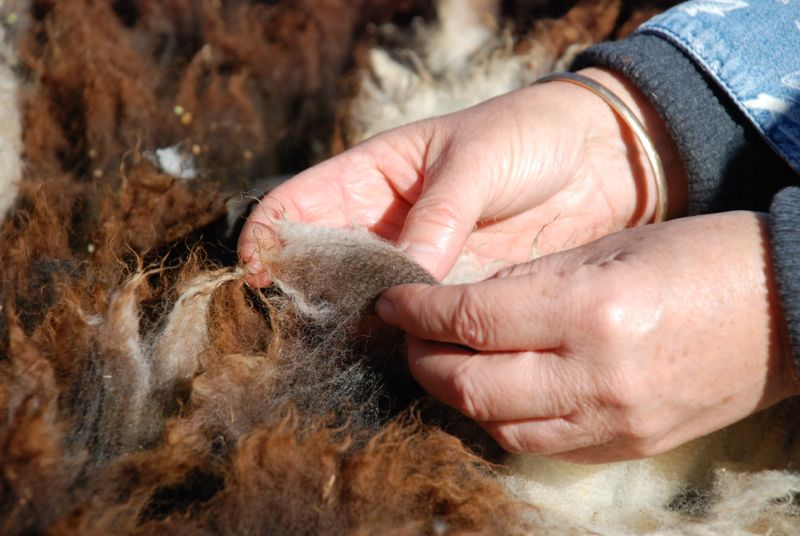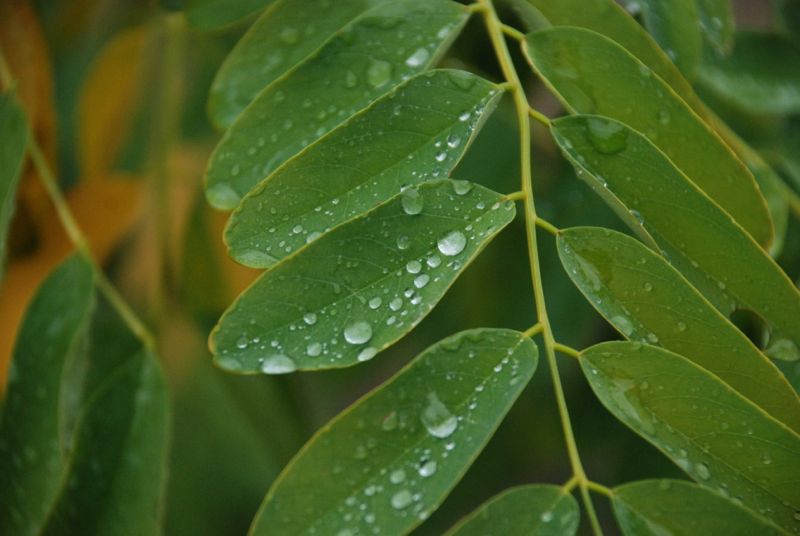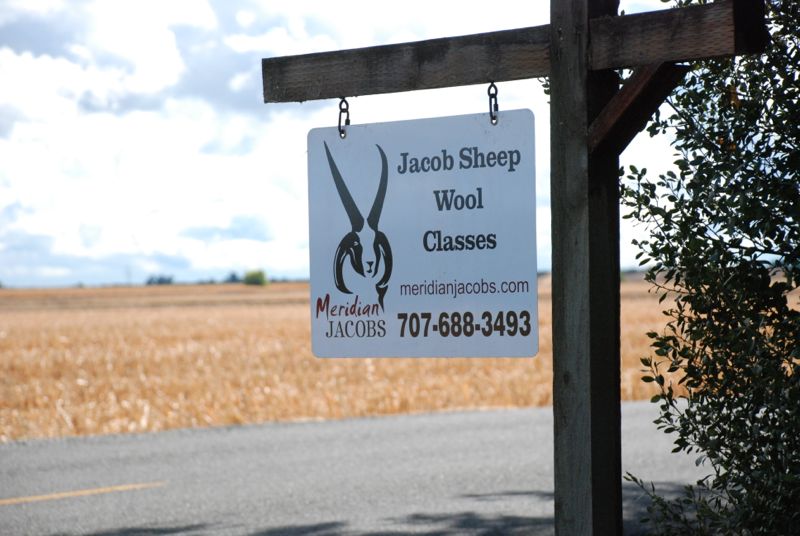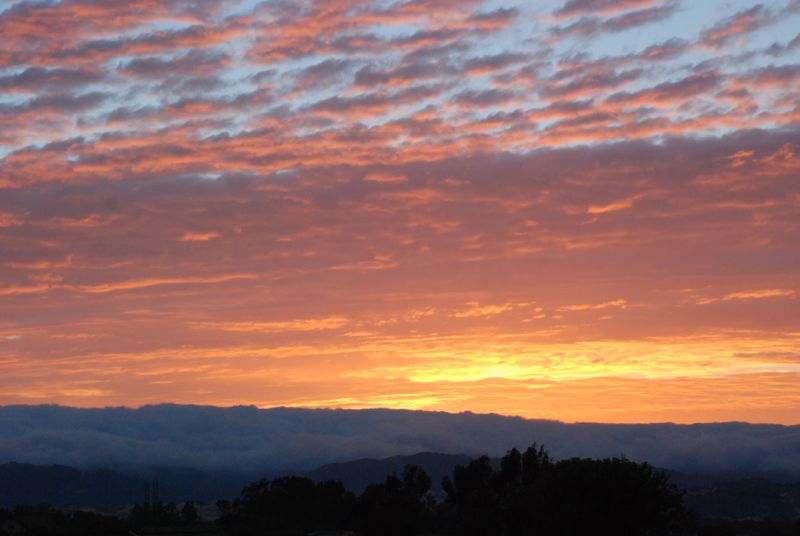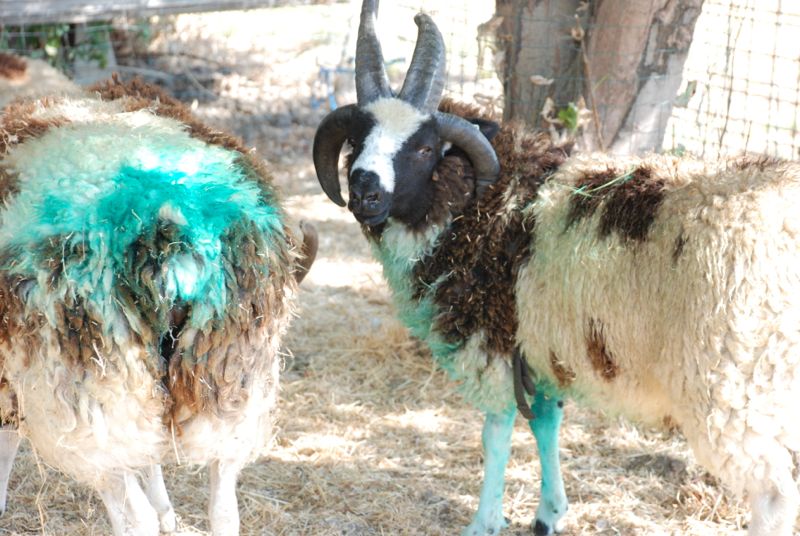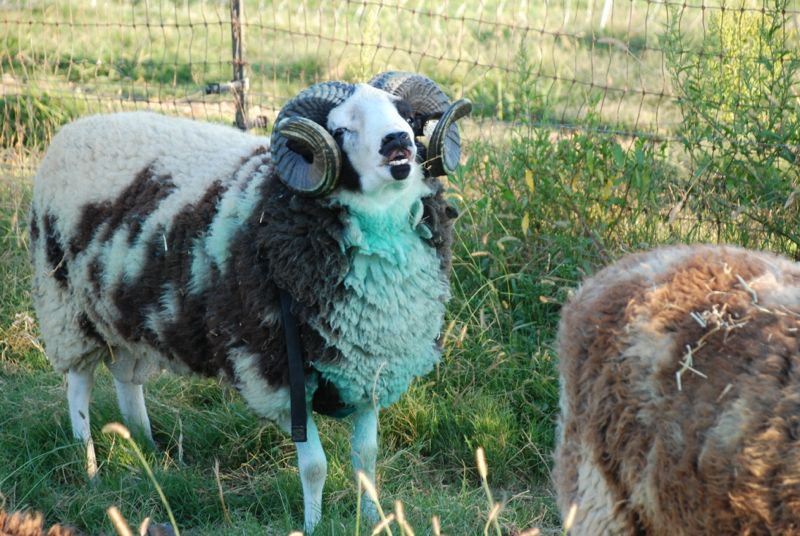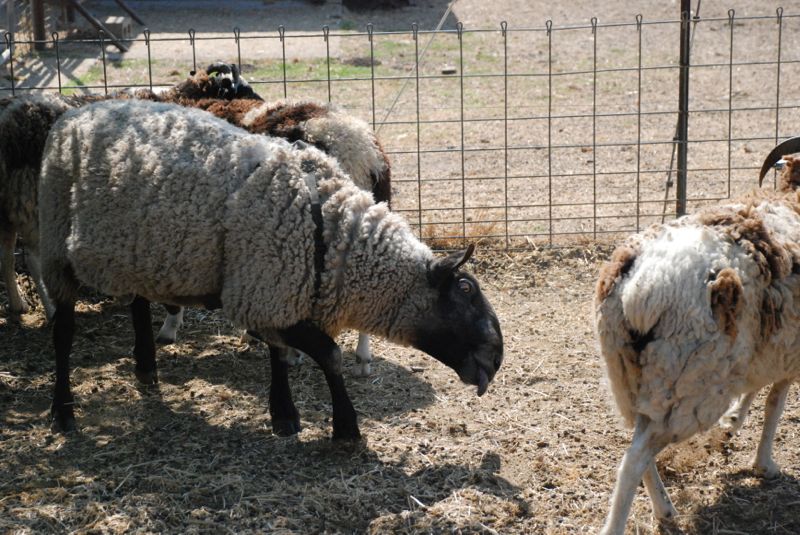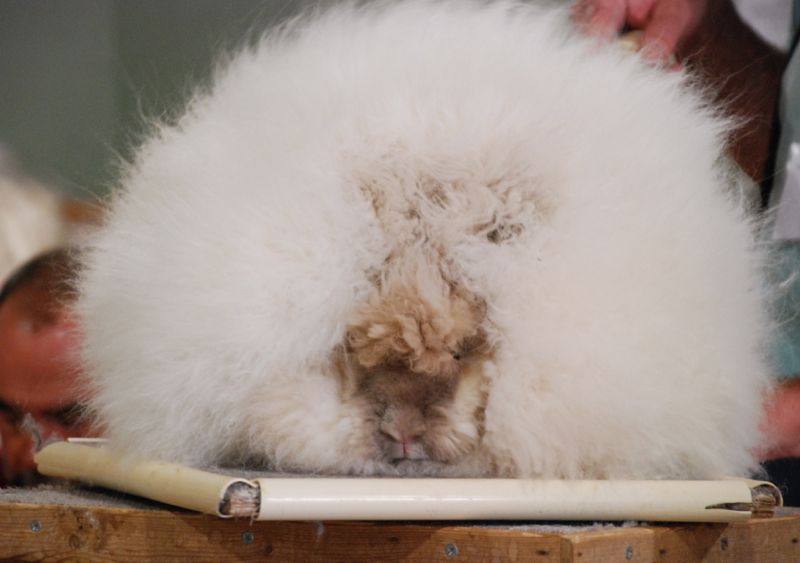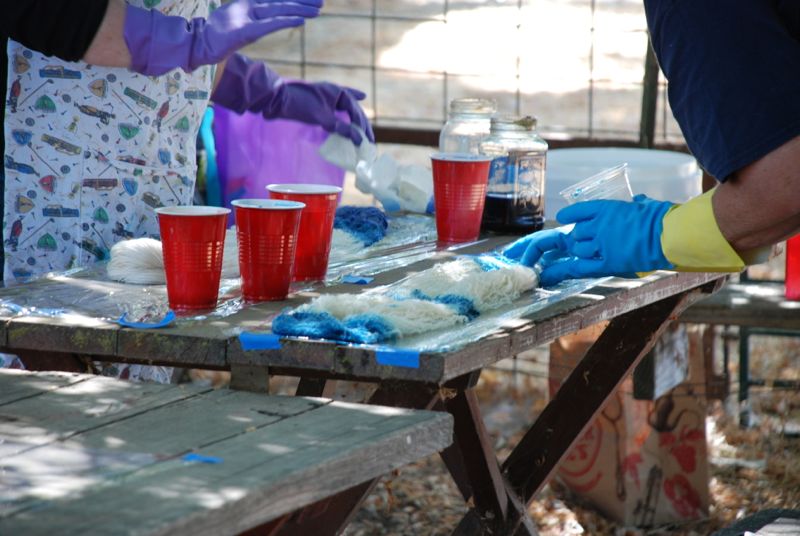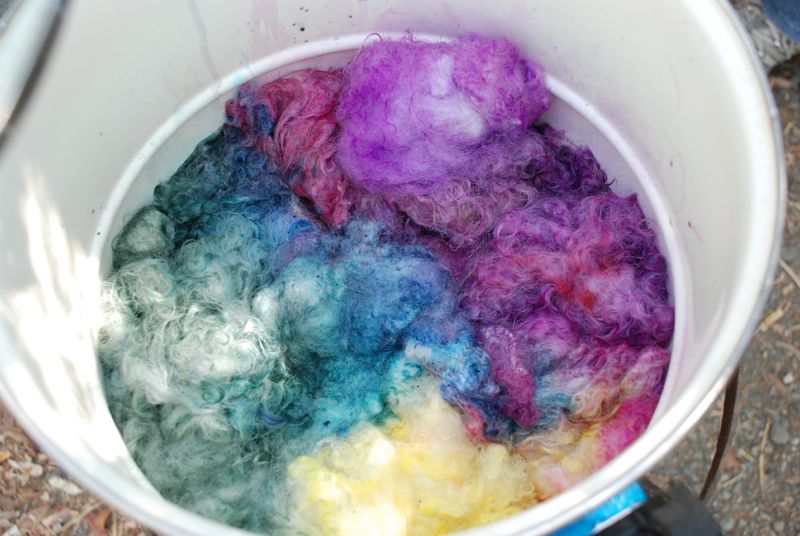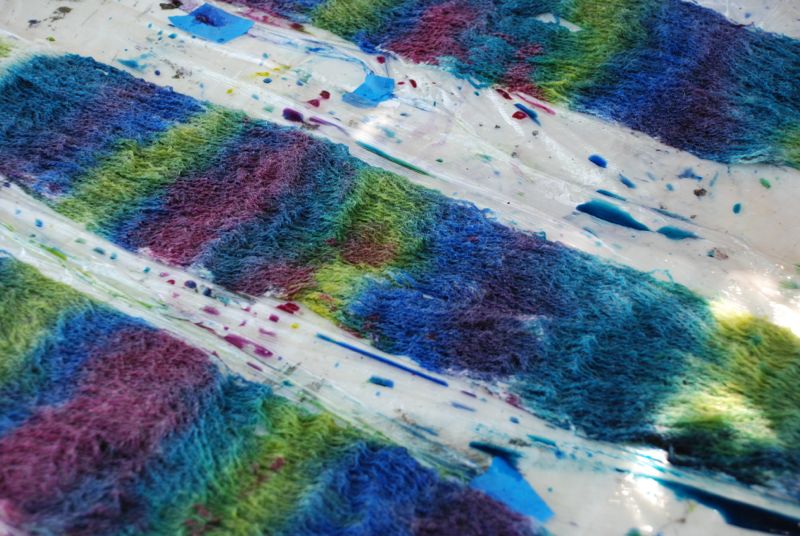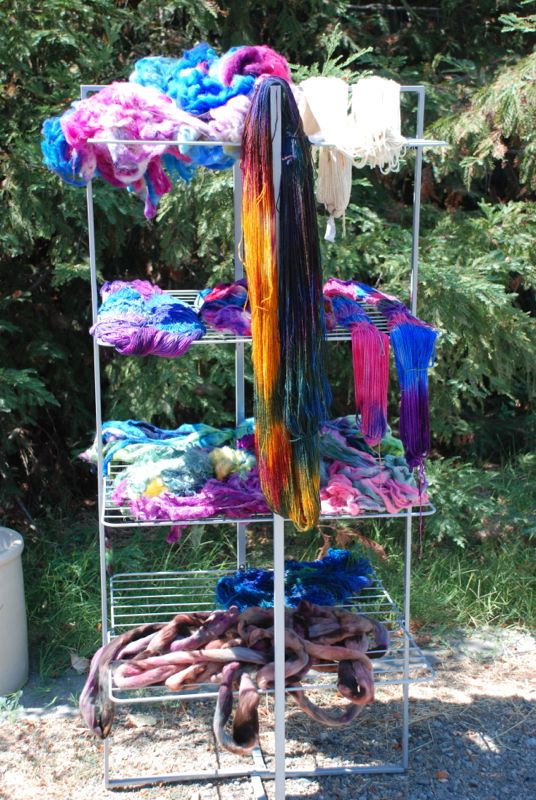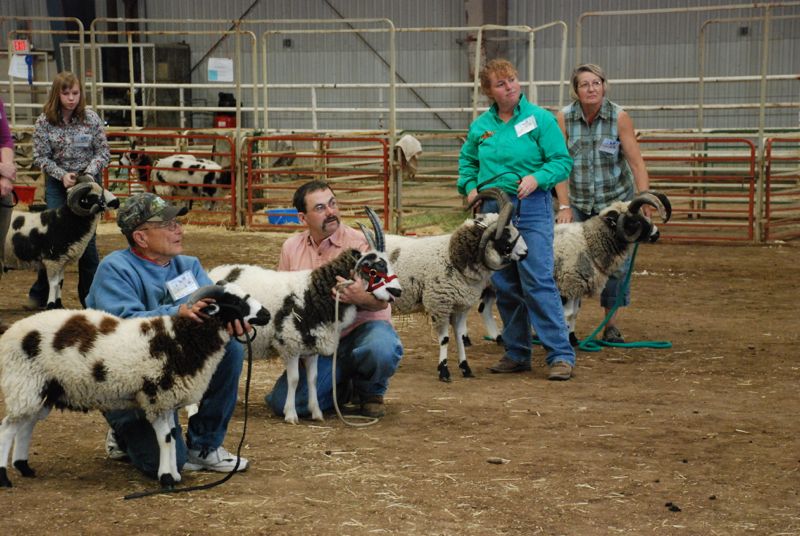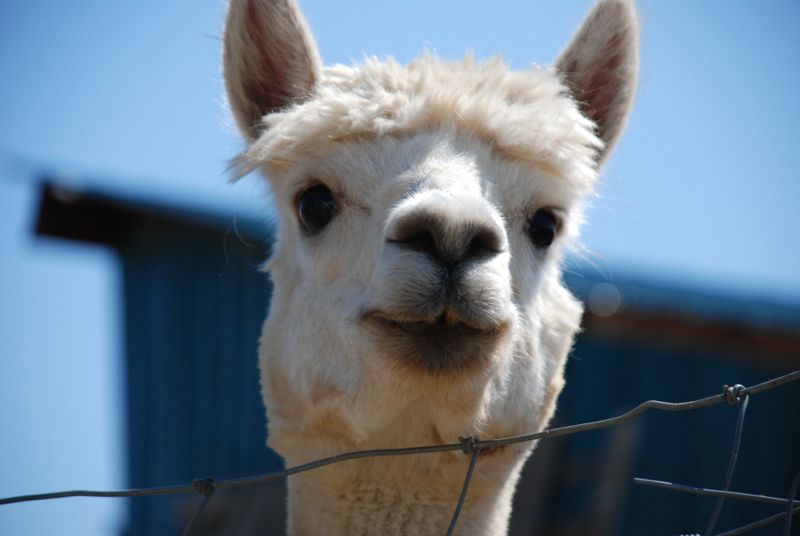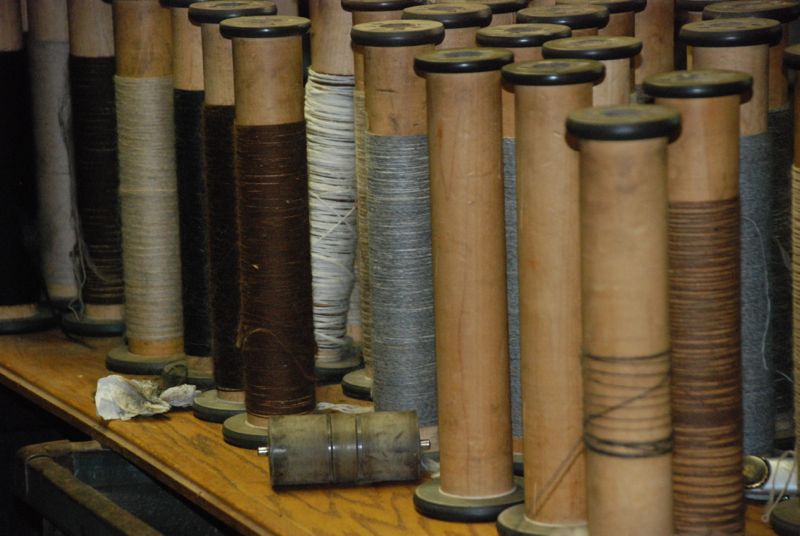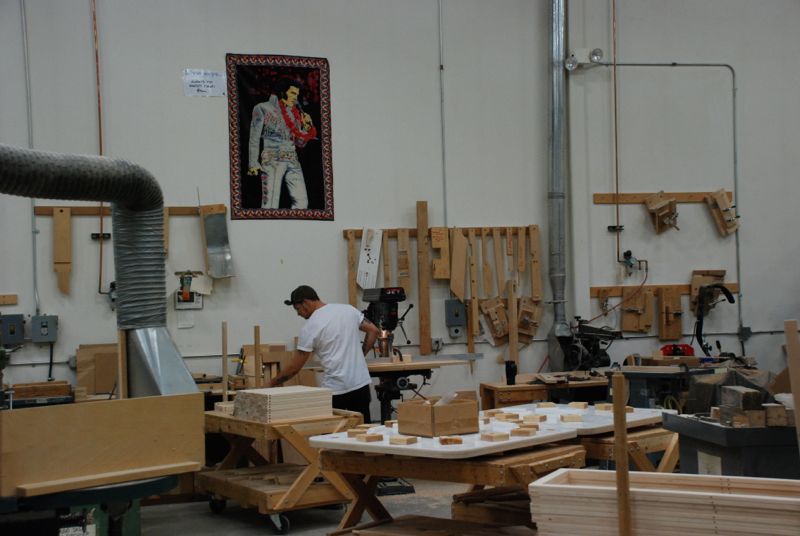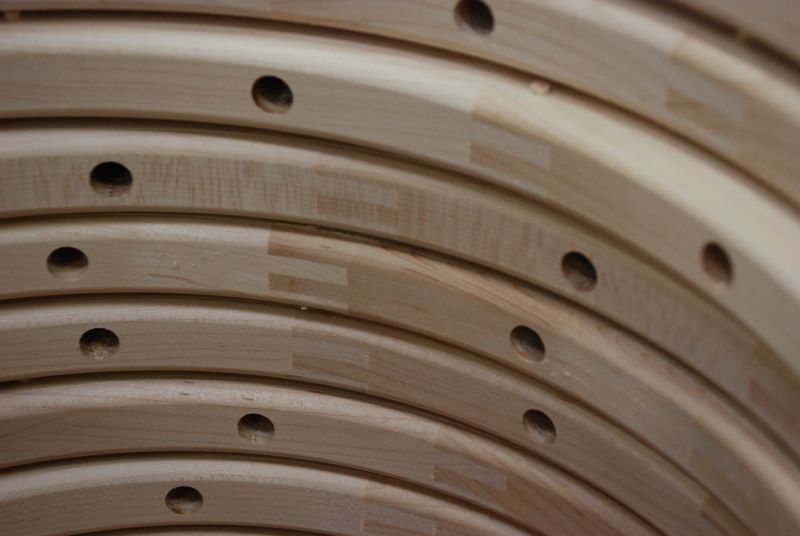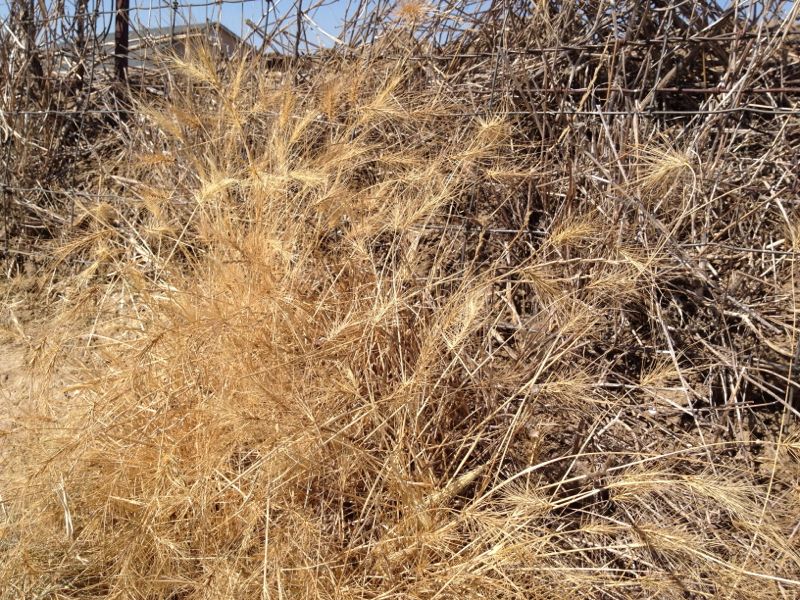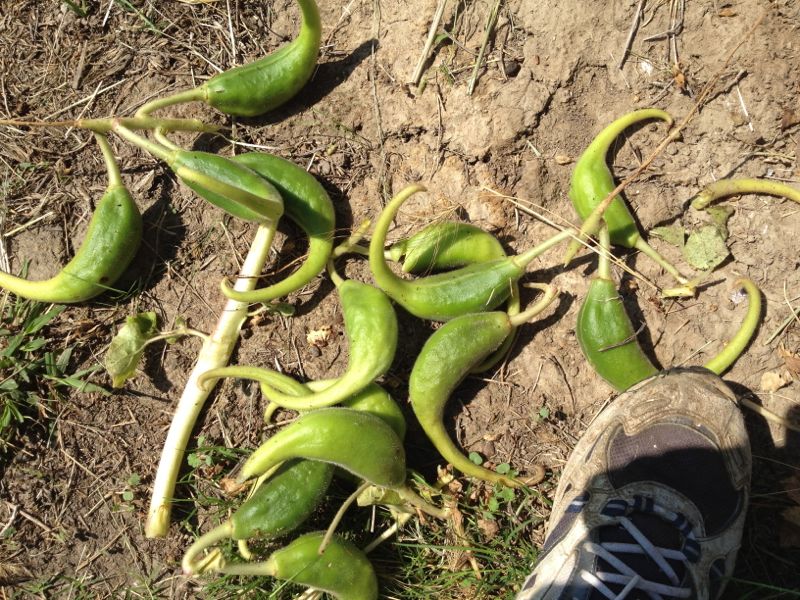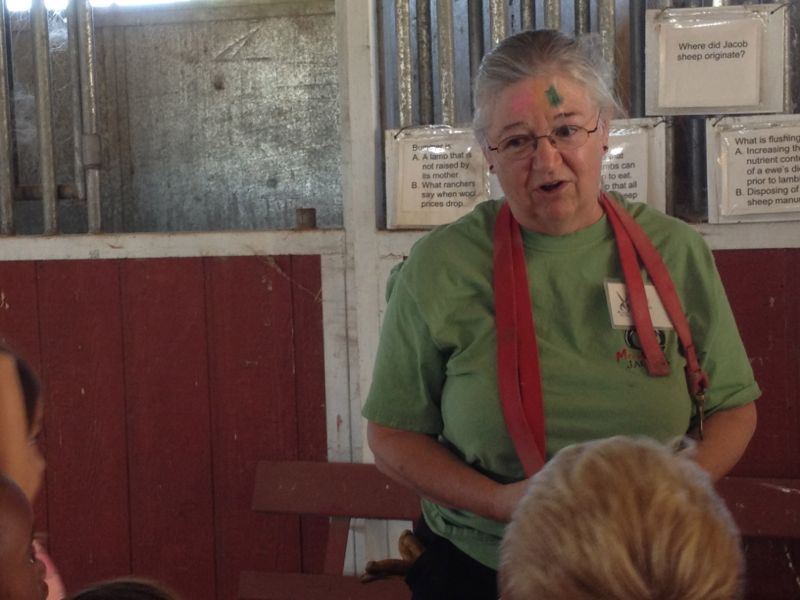Fondling Fleeces
/On Shearing Day I sold over 20 fleeces but I was so busy that I didn't get a change to really look at them. Today some Farm Club members came to help skirt and sort fleeces.
 Most of the fleeces that are left will be sorted into white, black, and gray. That's what those barrels in the background are for. However, I'm keeping my eyes open for a couple of fleeces for some special projects that I have in mind. The wool on the table is Donna's fleece.
Most of the fleeces that are left will be sorted into white, black, and gray. That's what those barrels in the background are for. However, I'm keeping my eyes open for a couple of fleeces for some special projects that I have in mind. The wool on the table is Donna's fleece.
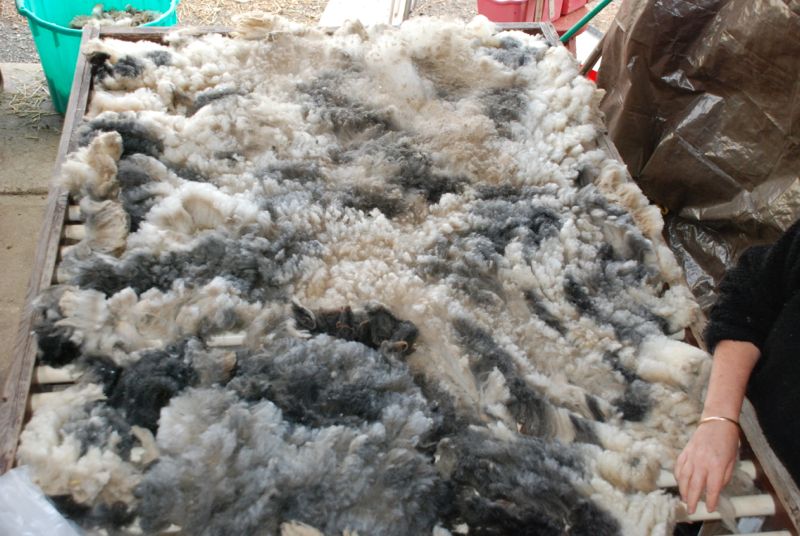 This is what Donna's fleece looks like from the cut side. Isn't that a beautiful shade of gray?
This is what Donna's fleece looks like from the cut side. Isn't that a beautiful shade of gray?
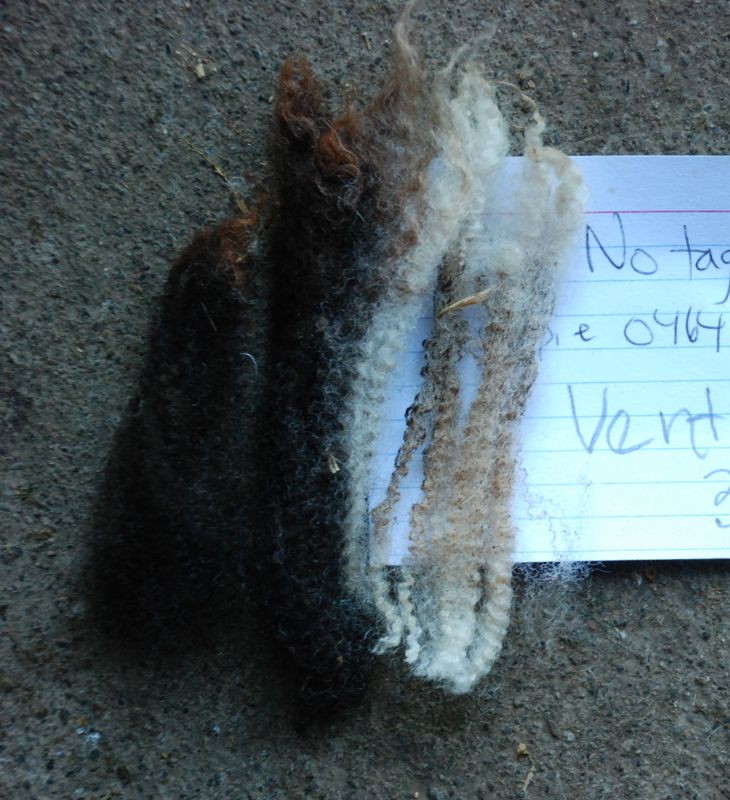 Here is a sample of Ventura's fleece. This is another that I may spin myself.
Here is a sample of Ventura's fleece. This is another that I may spin myself.
Here are some more pretty fleeces.
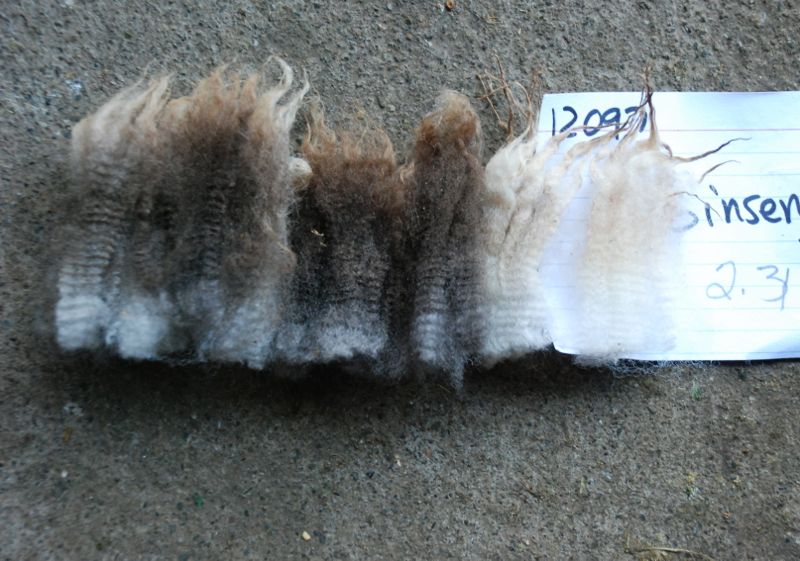 Ginseng is a lilac lamb. Notice the change in color in the length of the staple--lightest color near the skin. It will be interesting to see what this fleece is like next year.
Ginseng is a lilac lamb. Notice the change in color in the length of the staple--lightest color near the skin. It will be interesting to see what this fleece is like next year.
 This is Ginseng and her spots don't appear light.
This is Ginseng and her spots don't appear light.
Onyx's fleece. I'm keeping this one also.
Dallisgrass revisited
/I have posted several times about dallisgrass in the pasture. It features in this post a few years ago, this this post about burning it, this post in August 2011 and this post in August 2012. Please ignore the fact that I have spelled it differently in several of this posts. It is dallisgrass and here is a definition: "a tall tufted tropical South American perennial grass (Paspalum dilatatum) introduced as a pasture and forage grass in the southern United States". This came up in an e-mail conversation last night. Why don't I shear before breeding season to avoid the blue and red and green markings on the wool?
 Good question and that is a discussion for another post. I was thinking about pros and cons of shearing before breeding--sometime in September. I was explaining that the dallisgrass grows so tall and develops seed heads in the late summer. At some point in the cycle the seed heads are very sticky and the sheep (and Rusty...
Good question and that is a discussion for another post. I was thinking about pros and cons of shearing before breeding--sometime in September. I was explaining that the dallisgrass grows so tall and develops seed heads in the late summer. At some point in the cycle the seed heads are very sticky and the sheep (and Rusty...
...and my pants) are covered with sticky goo that catches dirt and the seeds that come off of the grass. After a few weeks the sticky part goes away and then fall rains clean the sheep. I thought I'd look this up to see why the seed heads are so sticky. I was surprised to learn that the goo is actually the result of a fungus that is common on dallis grass and is toxic to cattle. Who would have thought? That doesn't change anything, but I find it interesting. So this morning I wanted to see for myself.
 This dallisgrass looks "clean".
This dallisgrass looks "clean".
 The dry grass here is dallisgrass.
The dry grass here is dallisgrass.
 See how tall and thick it is? Some of the leaves are still green, but they are so coarse that the sheep will choose to eat the dallisgrass only after they have eaten all the grass and clover that they prefer.
See how tall and thick it is? Some of the leaves are still green, but they are so coarse that the sheep will choose to eat the dallisgrass only after they have eaten all the grass and clover that they prefer.
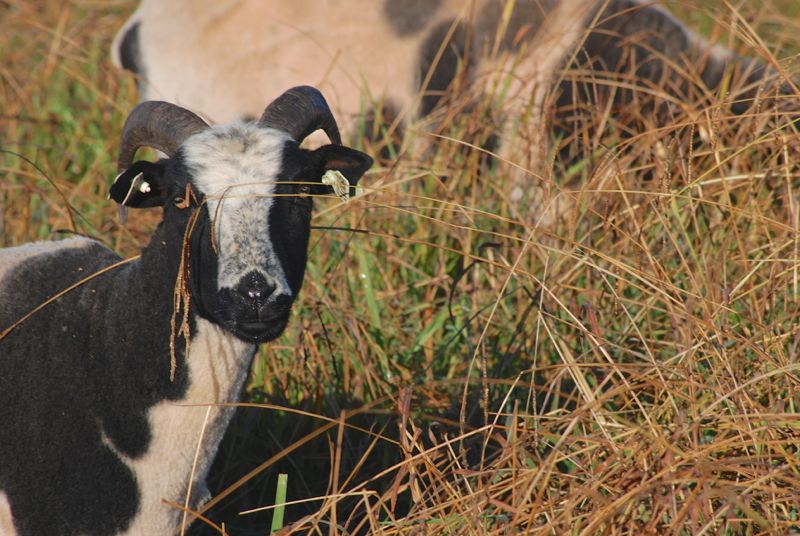 A few sheep photos. This is Sierra.
A few sheep photos. This is Sierra.
 This is Aurelia, the ewe I got from Kreutzer Farms in Nebraska.
This is Aurelia, the ewe I got from Kreutzer Farms in Nebraska.
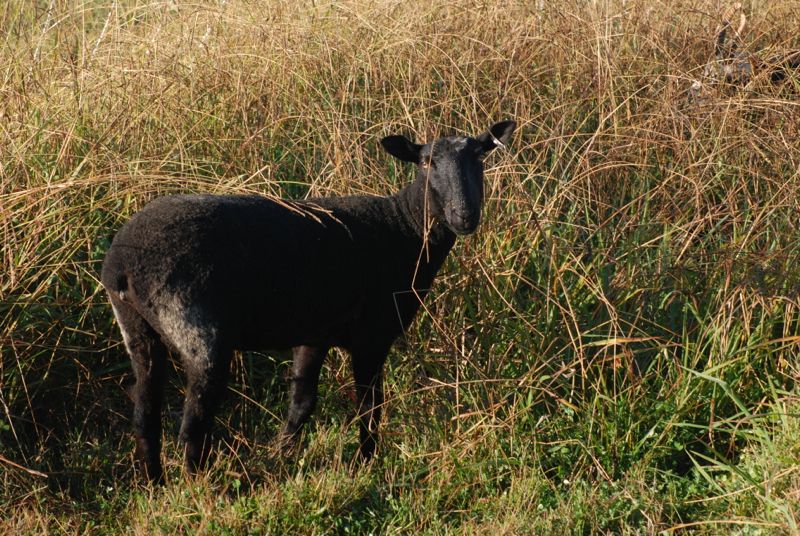 Onyx, the Jacob x BFL cross. Notice the ewe in the top right corner of the photo that is almost invisible in the tall grass.
Onyx, the Jacob x BFL cross. Notice the ewe in the top right corner of the photo that is almost invisible in the tall grass.
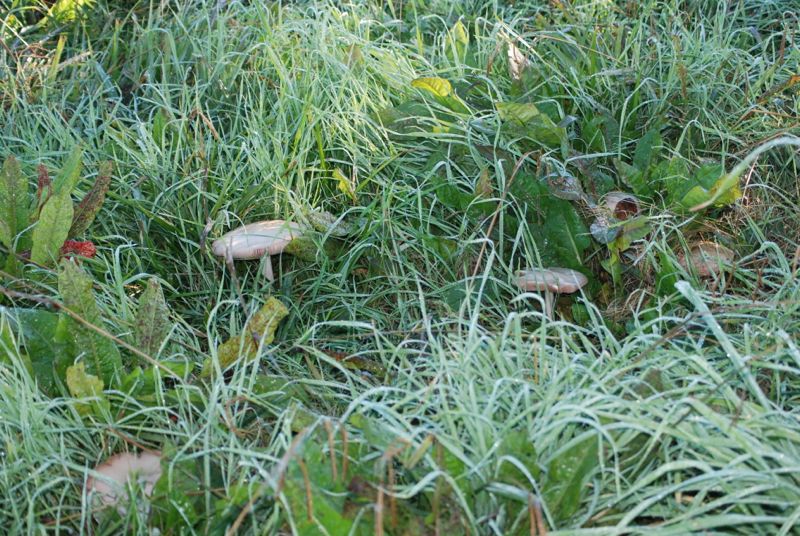 And while I'm talking about fungus in the pasture, what about this one?
And while I'm talking about fungus in the pasture, what about this one?
Shearing Day
/Shearing Day was yesterday. What a wonderful time. Farm Club came through (as always) and handled all the various tasks of the day. (Except for Rusty's job, which he describes in his blog so I am not duplicating his photos here). I am grateful to the great shearer who has come for the last few years. He does a wonderful job--the sheep look good and the fleeces look good. John is so fast that he finished with 64 sheep in about 2 1/2 hours.
 One important job is making sure that the shearer always has a sheep to shear as soon as he finishes with the last one.
One important job is making sure that the shearer always has a sheep to shear as soon as he finishes with the last one.
 I took some videos too but it will take me awhile to get those edited. You can sign up on the Meridian Jacobs YouTube Channel and see them when they are ready.
I took some videos too but it will take me awhile to get those edited. You can sign up on the Meridian Jacobs YouTube Channel and see them when they are ready.
 This is the BFL/Jacob crossbred ewe. I probably could have started a bidding war on her fleece, but I'm keeping it.
This is the BFL/Jacob crossbred ewe. I probably could have started a bidding war on her fleece, but I'm keeping it.
 A couple of people bagged fleeces after shearing and then each fleece was weighed.
A couple of people bagged fleeces after shearing and then each fleece was weighed.
 Alison and Linda helped many new Farm Club members and other visitors evaluate fleeces at the skirting table.
Alison and Linda helped many new Farm Club members and other visitors evaluate fleeces at the skirting table.
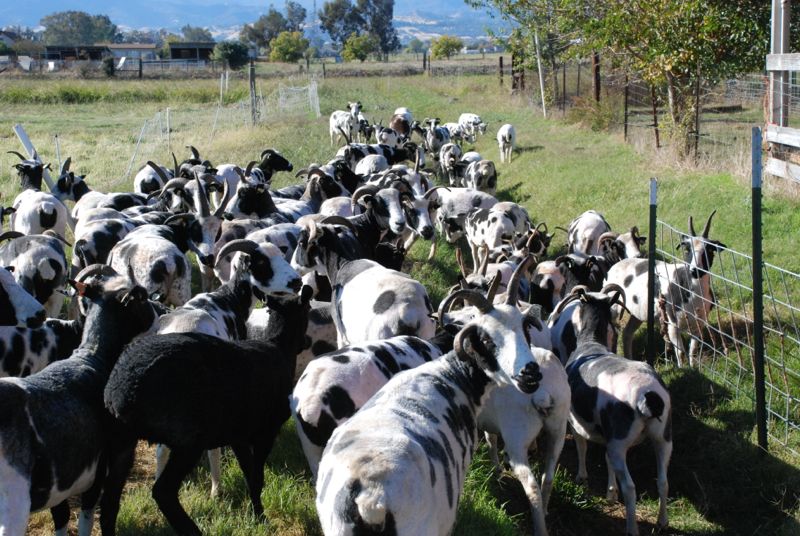 The warm afternoon sun was welcome after the cold morning.
The warm afternoon sun was welcome after the cold morning.
 Good friendships and sharing the work make a day like this extra fun.
Good friendships and sharing the work make a day like this extra fun.
Want a Hug?
/How exciting! Thanks to Dona, who photographed us, we made the Hug A Sheep Day blog with this photo of Farm Club.
 It was a great day to Hug a Sheep and we hugged several! If you want to read about the other things we did yesterday (from Rusty's perspective) read Rusty's blog.
It was a great day to Hug a Sheep and we hugged several! If you want to read about the other things we did yesterday (from Rusty's perspective) read Rusty's blog.
Rain
/Look at what we woke up to this morning. Rain! I know I won't be so happy about it by February or so, but it is a welcome sight now. There are months of dust and dirt to wash off of plants and sheep and this will get the winter grass to start growing.
Here is the beautiful sky across the road while I was taking the photo below...
...to use in a PowerPoint presentation I was preparing for a talk about Sustainable Fiber in San Francisco tonight.
A gorgeous sky in the city too. This is the view from the Ferry Building before it started raining again.
Color Everywhere I Look
/It's been awhile since I wrote a blog post--at least on paper...well, on on the computer. But you know what I mean. I write a lot of them in my head but they don't always make it here. So I was looking at my latest photos to see which in-my-head blog post to put here and these are the things that caught my eye.
 The dye class that I taught last week.
The dye class that I taught last week.
 The v-shawl class that I taught last week.
The v-shawl class that I taught last week.
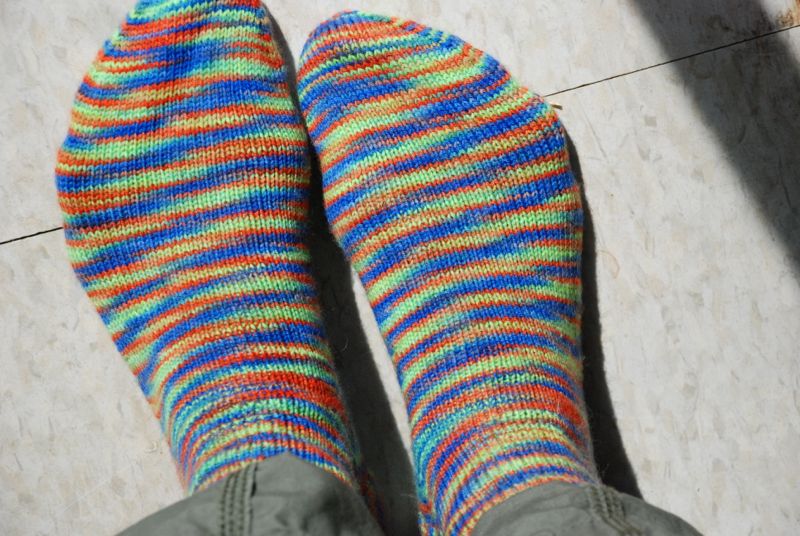 Socks that Jackie made for me but it hasn't been the season to wear them.
Socks that Jackie made for me but it hasn't been the season to wear them.
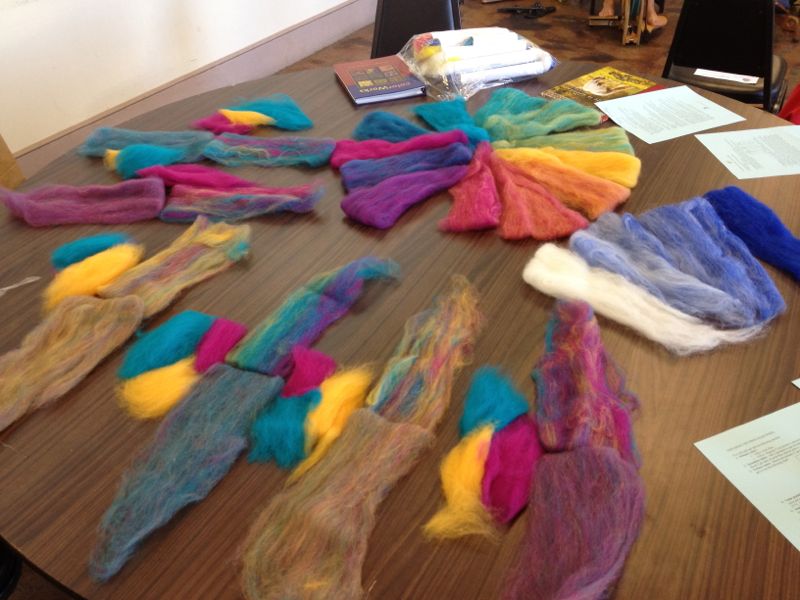 The color wheel class that I taught at Lambtown on Sunday.
The color wheel class that I taught at Lambtown on Sunday.
 Georgia O'Keefe's Purple Petunia which is now on the loom.
Georgia O'Keefe's Purple Petunia which is now on the loom.
But when you think you've found the most fabulous colors of yarn, fiber, and dye, you walk outside and see this:
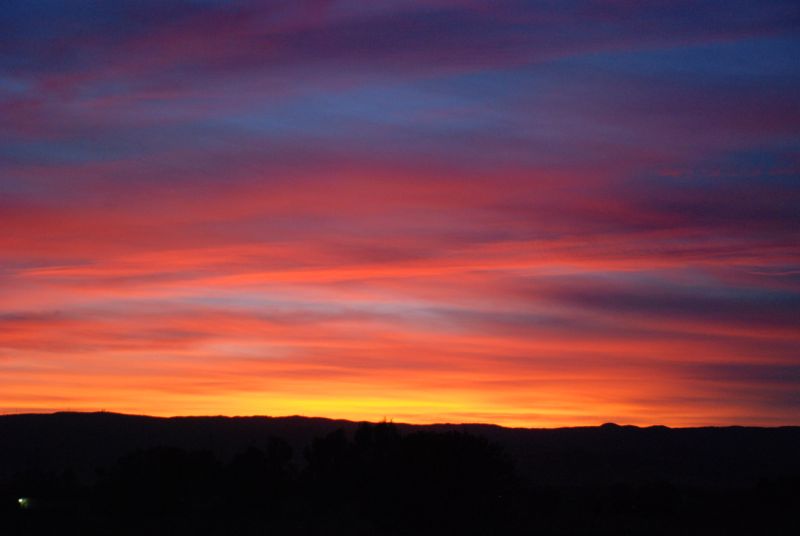 I think I need to find yarn in these colors.
I think I need to find yarn in these colors.
Breeding Season is Here
/Four Farm Club members came today to help me sort out breeding groups. I told myself that using four rams was plenty but in the end I put ewes with six rams. I don't have a very big place and by the time I save spaces for non-breeding rams (a few ram lambs left), non-breeding ewes (my State Fair ewes and lambs and a few ewe lambs that I don't want to breed yet) and try to leave buffer spaces between breeding groups it gets tricky to find space for everyone. Kenleigh's Matrix, a ram lamb, was the first to go out with 14 ewes.
 Meridian Loretta was obviously in heat, but we wondered if Matrix, smaller than the ewes, was going to manage the job.
Meridian Loretta was obviously in heat, but we wondered if Matrix, smaller than the ewes, was going to manage the job.
 Meridian Fogerty, a yearling ram, was next. He has 8 ewes.
Meridian Fogerty, a yearling ram, was next. He has 8 ewes.
 Faulkner was happy to be given eight ewes.
Faulkner was happy to be given eight ewes.
 Meridian Clapton, the ram who has been behaving badly wanted some of the action.
Meridian Clapton, the ram who has been behaving badly wanted some of the action.
 Clapton is temporarily in a small pen so he has just three ewes.
Clapton is temporarily in a small pen so he has just three ewes.
 Puddleduck Sullivan has ten ewes.
Puddleduck Sullivan has ten ewes.
When you first put the rams with the ewes they get a little carried away trying to find a ewe in heat and you may see random marks on some of the ewes. One of the Farm Club members asked how you can tell if the marks from the ram harnesses are the "real thing". I told her that you can tell.
 This is in Fogerty's pen later in the day.
This is in Fogerty's pen later in the day.
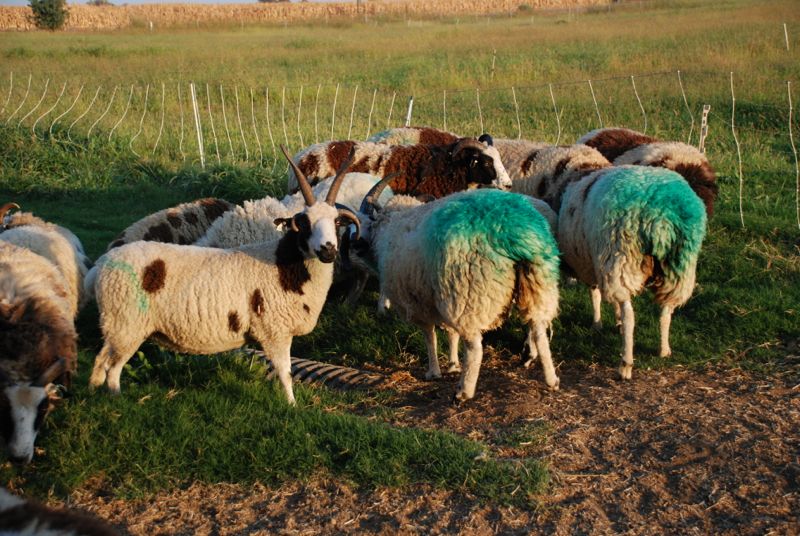 These are two of Matrix's ewes. One is Loretta, the ewe in the first photo.
These are two of Matrix's ewes. One is Loretta, the ewe in the first photo.
It wasn't until the end of the day that I picked up the marker for the sixth ram harness so Meridian Miller (the ram lamb who was champion at the State Fair) didn't get his 7 ewes until evening. He is in the pen right behind my shop.
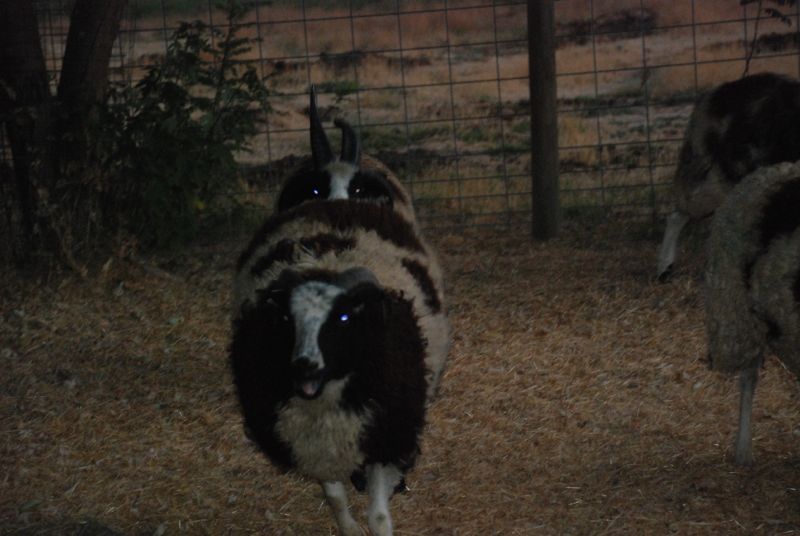 You could say that the ewes were a bit stand-offish, but Miller didn't let that deter him.
You could say that the ewes were a bit stand-offish, but Miller didn't let that deter him.
Where will you be February 21? I'll be in the barn with new lambs.
CA Wool & Fiber Festival
/I spent last weekend in Boonville at the CA Wool & Fiber Festival which is part of the Mendocino County Fair and Apple Show. I was a vendor at CWFF years ago but this the first time in quite awhile for me. This is a fun show but the hours and the drive make for a long weekend. I left home Thursday afternoon and finally finished setting up the booth about 10:30 that night. By the time I packed up on Sunday night it was 10:30 and I got home at 2:30 a.m. Monday. Good thing I had a good audio-book for the drive.
 My 10 x 10 booth was packed full of my farm-produced items as well as retail equipment, kits, etc.
My 10 x 10 booth was packed full of my farm-produced items as well as retail equipment, kits, etc.
 I entertained myself by needlefelting my first 2-dimensional piece...
I entertained myself by needlefelting my first 2-dimensional piece...
 ...spinning on the new Country Spinner from Ashford...
...spinning on the new Country Spinner from Ashford...
 ...visiting with Jackie, who was a great help at the booth, and...
...visiting with Jackie, who was a great help at the booth, and...
 ...watching people try on the fuzzy hats in the booth across the aisle.
...watching people try on the fuzzy hats in the booth across the aisle.
 I have been friends with Karin since 5th grade and she came for a visit. That's her between the cowboys, who are also very entertaining.
I have been friends with Karin since 5th grade and she came for a visit. That's her between the cowboys, who are also very entertaining.
 I bought this very cool horse necklace from the Navajo ladies who had a booth across the aisle. I have worn the same earrings for about a year and I never buy jewelry, but I couldn't resist.
I bought this very cool horse necklace from the Navajo ladies who had a booth across the aisle. I have worn the same earrings for about a year and I never buy jewelry, but I couldn't resist.
Although it's hard for some of us to understand, the world doesn't revolve around fiber, at least the furry kind of fiber. This is the County Fair and APPLE Festival. After the fiber building closed in the evening I had a chance to see a few more things at the fair.
 I enjoyed seeing the exhibits created by youth groups to promote local agriculture. Who knew that there was this additional use for yellow squash?
I enjoyed seeing the exhibits created by youth groups to promote local agriculture. Who knew that there was this additional use for yellow squash?
I found another old friend.
 This is Freckles, who I sold a few years ago to someone with a petting zoo. What a good life for a sheep who would be culled!
This is Freckles, who I sold a few years ago to someone with a petting zoo. What a good life for a sheep who would be culled!
Back to the fiber building.
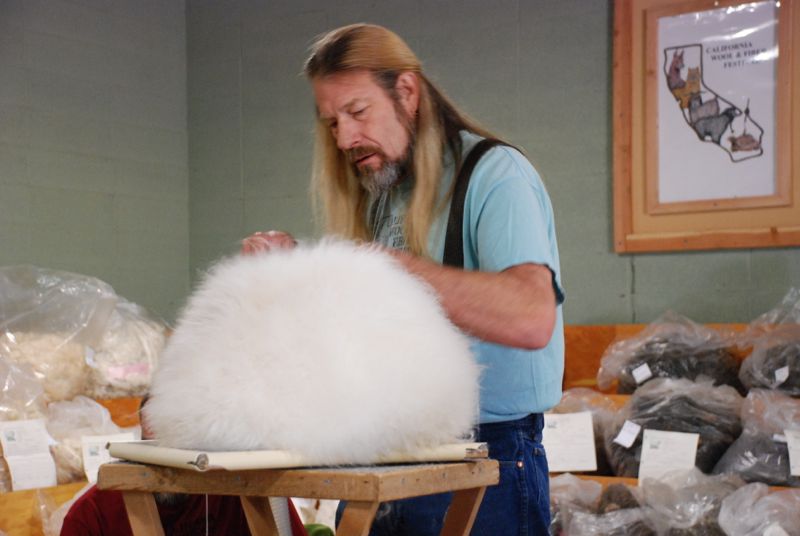 On both Saturday and Sunday Charlie demonstrated his skill with his chosen fiber animal.
On both Saturday and Sunday Charlie demonstrated his skill with his chosen fiber animal.
 Charlie harvests the fiber with scissors.
Charlie harvests the fiber with scissors.
 He makes sure that there are no second cuts or short fibers in the prime fiber he saves. Too bad you can't do that with sheep.
He makes sure that there are no second cuts or short fibers in the prime fiber he saves. Too bad you can't do that with sheep.
Fun friends, fun weekend, but long. I'm glad to be home and sleeping in a bed instead of the back of the truck. Oh, there was a sheepdog trial also. I'm going to let Rusty tell you about those photos in his blog.
Kids
/How many of you have a big box of things that your kids brought home to you and were too special to part with? Here are some photos of a few mementos that are not in boxes but are around the house and shop.
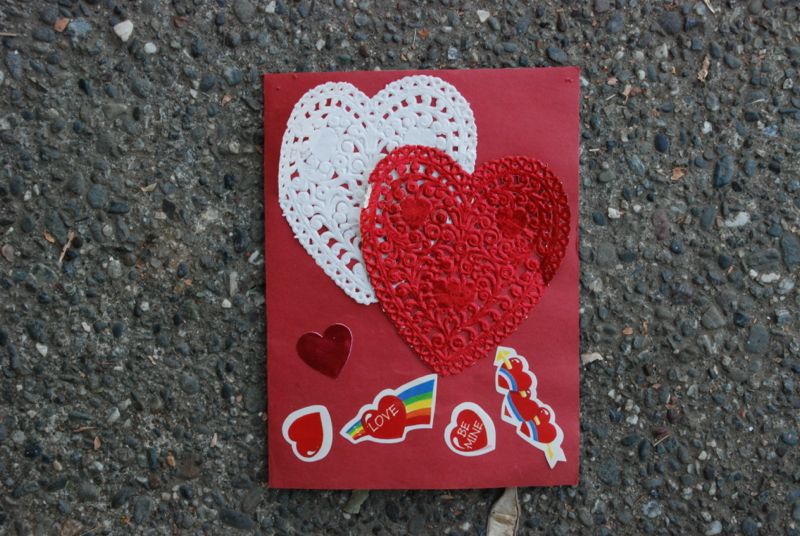
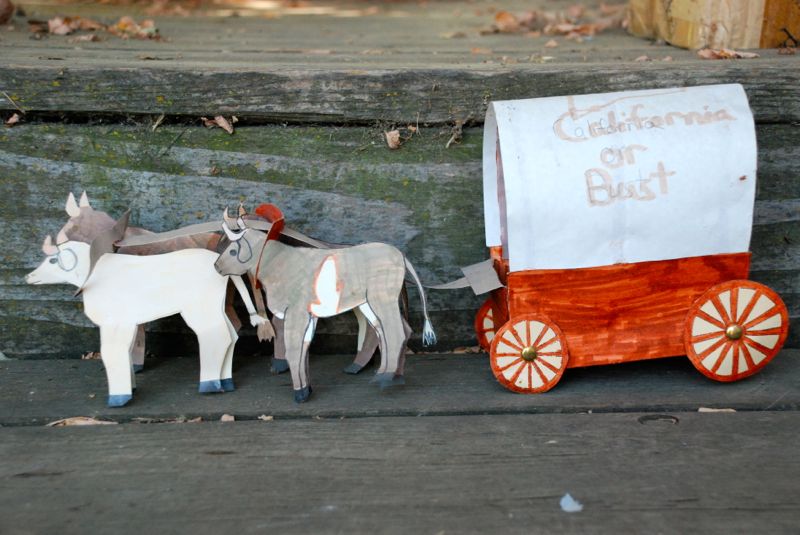 Probably 1998 or so. Two of the oxen have the markings of my steers I was training to be oxen.
Probably 1998 or so. Two of the oxen have the markings of my steers I was training to be oxen.
 2012, Brought to me from the fire-line.
2012, Brought to me from the fire-line.
JSBA AGM (Colorado - Day 1-3)
/We crammed a lot into only a couple of days. AGM (Annual General Meeting) is always fun because you see people who you may only see once a year (or less). Because the AGM is held all over the country and at different times of year, not everyone can go to them all. There was a pretty good turnout in Colorado. Here are some photos of the activities.

Friday evening wool show.
Friday evening Spinners' Lead contest for juniors...
...and for Seniors.
 "Make sure that you see the socks too."
"Make sure that you see the socks too."
 Saturday afternoon presentation about The Effects of Nutrition on Fiber Production.
Saturday afternoon presentation about The Effects of Nutrition on Fiber Production.
 Also Saturday afternoon--AFD (Average Fiber Diameter) testing for anyone who brought wool samples (or took scissors and cut samples from the sheep that were there). This is Ron Cole from ASI, who taught the Wool Handling Workshop in California a few months ago. He brought the OFDA (optical-based fiber diameter analyser) used to measure wool samples and I think he ran about 200 in the few hours he was there. AFD and some of the other statistical measurements are of importance to sheep farmers because it is AFD that determines the best use and the market for wool.
Also Saturday afternoon--AFD (Average Fiber Diameter) testing for anyone who brought wool samples (or took scissors and cut samples from the sheep that were there). This is Ron Cole from ASI, who taught the Wool Handling Workshop in California a few months ago. He brought the OFDA (optical-based fiber diameter analyser) used to measure wool samples and I think he ran about 200 in the few hours he was there. AFD and some of the other statistical measurements are of importance to sheep farmers because it is AFD that determines the best use and the market for wool.
 A wool sample is placed between two screens and thousands of measurements are taken in a few seconds time.
A wool sample is placed between two screens and thousands of measurements are taken in a few seconds time.
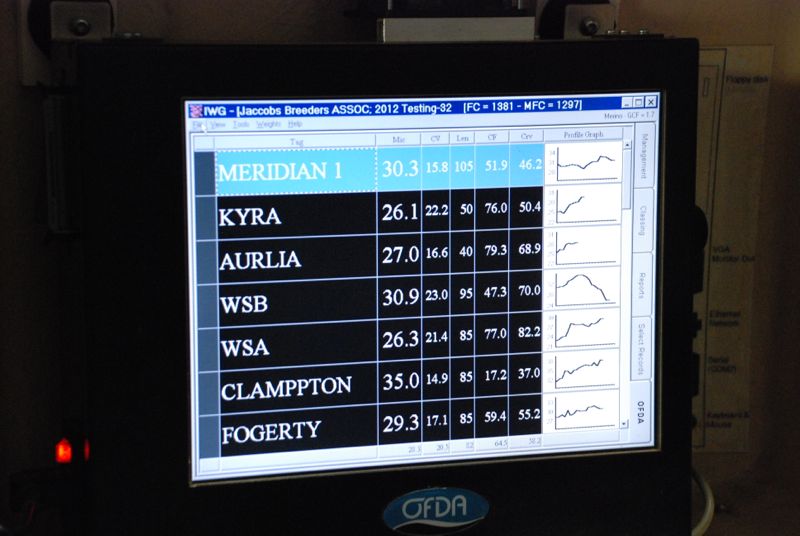 This is the information you get from the scans. I usually send in wool samples for all my yearlings so that I have micron data for each sheep at a consistent age. When they are sent to the lab you get this data back in printed format.
This is the information you get from the scans. I usually send in wool samples for all my yearlings so that I have micron data for each sheep at a consistent age. When they are sent to the lab you get this data back in printed format.
I should have taken a photo of dinner. It was fabulous Jacob lamb prepared by students in the meats lab at Colorado State (I think I have the school right) accompanied by corn, potatoes, and Colorado peach cobbler.
 After dinner there was a brief meeting and presentation of a Jacob wool shawl (made by me) to Jennifer, who organized the event.
After dinner there was a brief meeting and presentation of a Jacob wool shawl (made by me) to Jennifer, who organized the event.
 Throughout the day there was plenty of sheep shopping and trading going on.Most people who were hauling sheep left early Sunday morning. Some of us stayed around and drove a couple of hours up in the mountains to the Lonesome Stone Fiber Mill in Granby.
Throughout the day there was plenty of sheep shopping and trading going on.Most people who were hauling sheep left early Sunday morning. Some of us stayed around and drove a couple of hours up in the mountains to the Lonesome Stone Fiber Mill in Granby.
 What a beautiful area! Lonesome Stone currently has about 250 alpacas. We spent some time visiting with the alpacas before seeing the mill.
What a beautiful area! Lonesome Stone currently has about 250 alpacas. We spent some time visiting with the alpacas before seeing the mill.
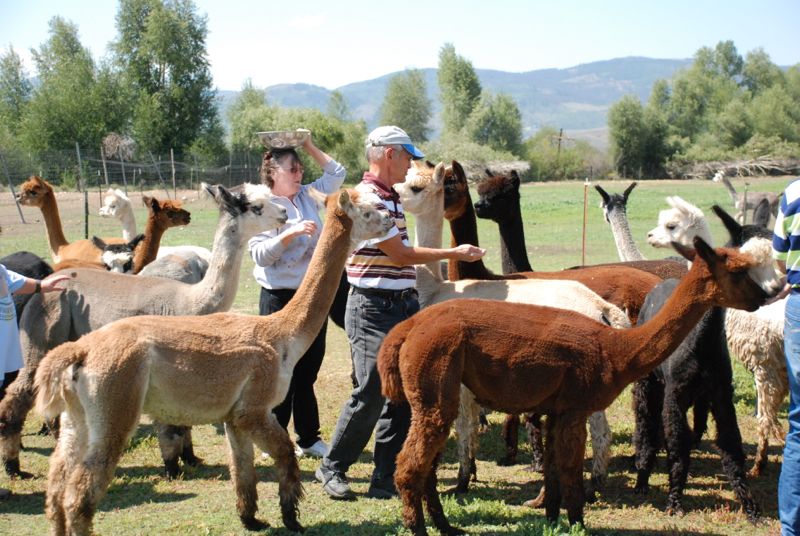 Note the bowl on the head method of bringing alpaca treats to the field. Once the bowl was lowered the treats were gone within seconds.
Note the bowl on the head method of bringing alpaca treats to the field. Once the bowl was lowered the treats were gone within seconds.
 Lonesome Stone is a favorite of alpaca growers, but they also process wool and any other fibers. When a producer sends raw fiber it is scoured, picked, carded, pin-drafted, spun, and plied. The yarn produced is beautiful. This is carded fiber going into the pin-drafter and coming out...
Lonesome Stone is a favorite of alpaca growers, but they also process wool and any other fibers. When a producer sends raw fiber it is scoured, picked, carded, pin-drafted, spun, and plied. The yarn produced is beautiful. This is carded fiber going into the pin-drafter and coming out...
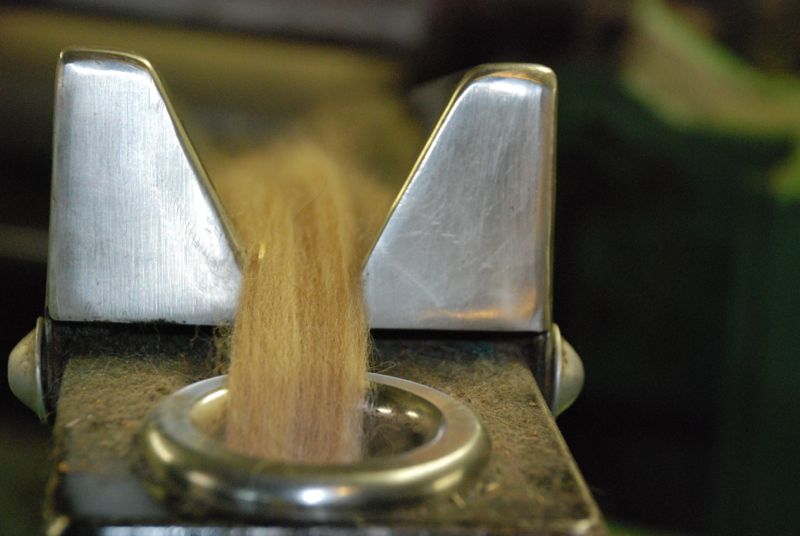 ...like this, ready to be spun.
...like this, ready to be spun.
 This is a corner of the store where the finished yarn is sold. Oh, did I say that Lonesome Stone also dyes the yarn?
This is a corner of the store where the finished yarn is sold. Oh, did I say that Lonesome Stone also dyes the yarn?
After this field trip I drove 3 hours to Colorado Springs to visit with my husband's sister and brother and their spouses, spending the night north of Colorado Springs. I left for the airport about 8:30 and got home around 4:30 p.m. It was a great weekend, but I am glad to be home. Tomorrow I'll be on the road at 5:30 a.m. to pick up my new sheep!
Trip to Colorado - Day 1 (2nd half)
/I am now at my brother-in-law's house in Colorado Springs and my computer is plugged in. I will finish the post of Friday's Events, but it seems like ages ago now. When I ran out of power last night I think I was including photos of things I thought interesting at Schacht Spindle Company...

...Like these rope twisters.
And this beautiful tapestry of Barry and Jane, their family, and other things of significance.
 Here is a farm related photo. This is a chicken coop outside of the building. Employees can sign up for chicken duty for a week. The employee who takes care of the chickens for the week and cleans the pen at the end of that time gets the eggs for the week. There are also garden plots that employees can use if they plant and maintain them.
Here is a farm related photo. This is a chicken coop outside of the building. Employees can sign up for chicken duty for a week. The employee who takes care of the chickens for the week and cleans the pen at the end of that time gets the eggs for the week. There are also garden plots that employees can use if they plant and maintain them.
After touring the business I drove to Shuttles, Spindles, and Skeins, the yarn shop in town.  Believe me, this is not your average yarn shop.
Believe me, this is not your average yarn shop.
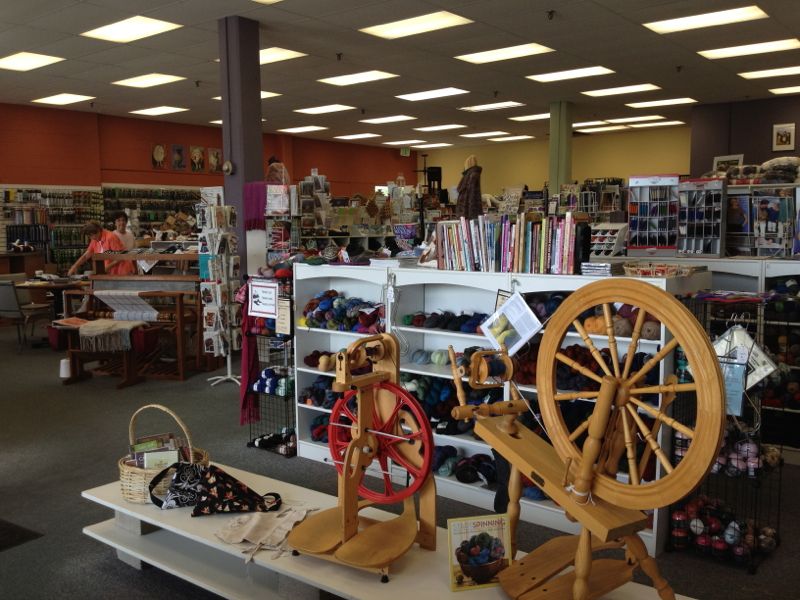 Here is what you see when you enter the shop.
Here is what you see when you enter the shop.
 Turn to the right and enter this room with coned yarn (off to the right of the photo), looms, wheels, and workshop space. Walk through this room into:
Turn to the right and enter this room with coned yarn (off to the right of the photo), looms, wheels, and workshop space. Walk through this room into:
 ...this classroom. You could probably fit 15 of my shop into this room alone.
...this classroom. You could probably fit 15 of my shop into this room alone.
 This is the other end of that room. Look at all those looms!
This is the other end of that room. Look at all those looms!
This poster caught my eye, partly because I had just been reading about the idea of "yarn crawls" in the Yarn Market News. Wouldn't this be a fun idea in our area?
Changing gears. I left Boulder and drove to Henderson to the Adams County Fairgrounds where the JSBA AGM was to be held. That will be the next post. Good night from Colorado. (My posts will be behind because I'll probably be home before I write the next one.)
Trip to Colorado-Day 1
/I flew to Colorado to attend the annual meeting of the Jacob Sheep breeders Association. The gathering started on Friday afternoon so I planned the day to include a side-trip to Boulder to visit the Schacht Spindle Company. I carry Schacht equipment in the shop so I thought it would be fun to have a tour of the business.

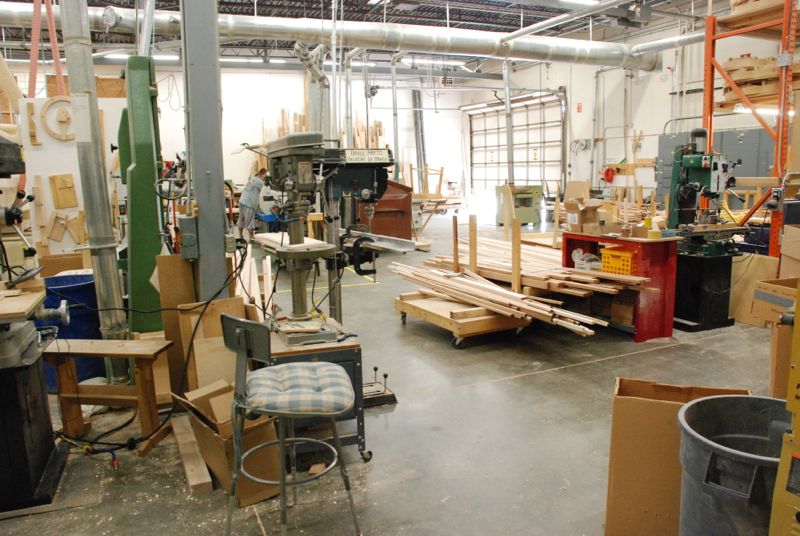 Here is the first look into the factory/workshop area. Looks confusing, doesn't it? There is a lot to see, but I'll just pick out a few photos to share.
Here is the first look into the factory/workshop area. Looks confusing, doesn't it? There is a lot to see, but I'll just pick out a few photos to share.
There are several big, fancy, and I'm sure very expensive machines like this one.
When you look closely you see that the machine is drilling and changing the block of wood on the left into the one on the right. This is one side of the Flip loom.
Each piece is sanded using a variety of machines--ones that do flat surfaces, ones like this one with stiff bristle rollers that sand inside all the crevices and holes.
Each piece is dipped in Danish oil. I love the smell when I open a box of Schacht products--I now associate that oil smell with new toys!
Work is done under the watchful eye of Elvis. (There is a sentimental story behind this.)
This is the room where the spinning wheels are put together. You know me with names...I can't remember this person's name but he puts together all the Schacht-Reeves wheels.
I am in my motel room. My computer just told me that I am on reserve power and it's going to go to sleep in a minute if I don't plug it in. I can't find the power cord and I hope it's in the car. I have to quite now. More later. I hope I have time to upload this.
Pasture Maintenance
/Nothing very exciting in this post. But I spent all day Sunday in the pasture after thinking the job at hand would take only a couple of hours. I find that I am always writing blog posts in my head so here it is.

I started by mowing the paddock that the sheep had just been grazing. Now that I have my mower (never meant for this heavy duty work, but so far still working) I have been working on the dallisgrass that gets ahead of the sheep this time of year. In the past I have tried burning, trampling, weed eating (photos and past efforts in this post and this post and this post), but I think this mower will be the answer. It is at the south end of my pasture(right side of the photo) that the dallisgrass gets so thick and tall. The idea is to mow right after grazing and then everything has an equal change of regrowth, and the dallisgrass will be in a more palatable stage and the sheep will keep up with the growth.
In this photo the paddock that I just mowed is to the right. The sheep grazed the one on the left a few days before. I mowed that one that last time they grazed it and that made a big difference. I shouldn't have to mow after each grazing--maybe once or twice per season I think. Notice the fence-line. That is a 3-wire electric fence and this was the other thing I wanted to deal with on this day. I have been putting off cleaning up the fence-line with the weed eater, but when you can't even see the wire, it's time. I have already used the weed-eater in the area where you can see the wire. This dallisgrass is tough. I have the heavy duty string on the weed-eater and it still gets used up quickly. Slow-going. It took me about 3 hours to finish this fence-line.
Speaking of problem plants, here is another. This is what the medusahead looks like when it's dry. There are plenty of posts about my battle with this noxious weed also. This is along the perimeter fence.
And lets not forget devils-claw. This one isn't so bad because I don't have much of it and it is easy to chop out the big plants. It doesn't invade the irrigated pasture, but is along the edges where it is dry.
What is the problem with devils-claw? See the fruit? See those curved, pointed ends? When the fruit dries it splits in two and those curved points get caught in wool. I'll show you other photos sometime. This is seed dispersal in action.
Moving on to other plant problems. This is the small blackberry bush on the west fence. On this morning I actually had breakfast here because the berries are ripe, but in general the blackberry bushes become a problem when they cover the electric fence as they do on my west fenceline. (Note wheelbarrow full of devils-claw.)
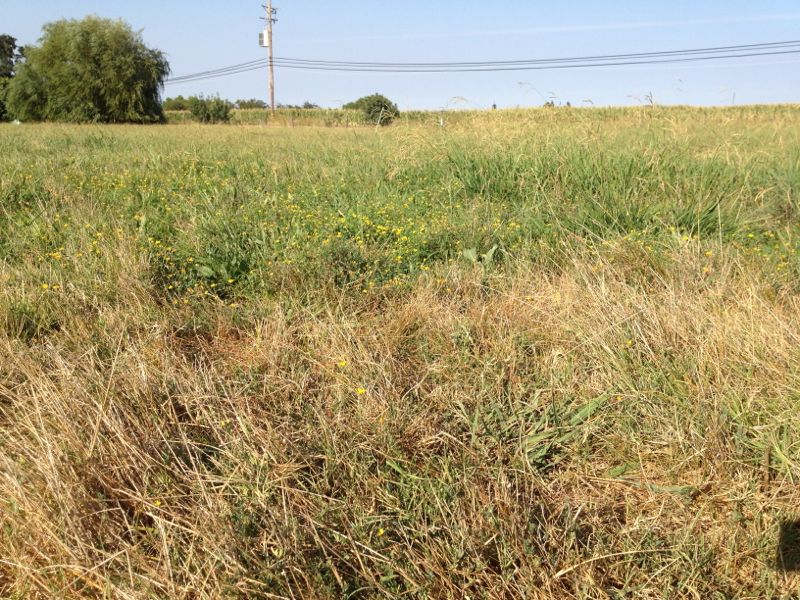 I started irrigating Sunday evening. Here is a spot that I hoped to get water to this time. The last few times I irrigated the water didn't get here.
I started irrigating Sunday evening. Here is a spot that I hoped to get water to this time. The last few times I irrigated the water didn't get here.
 This is the pathetic state of the trefoil that didn't get water.
This is the pathetic state of the trefoil that didn't get water.
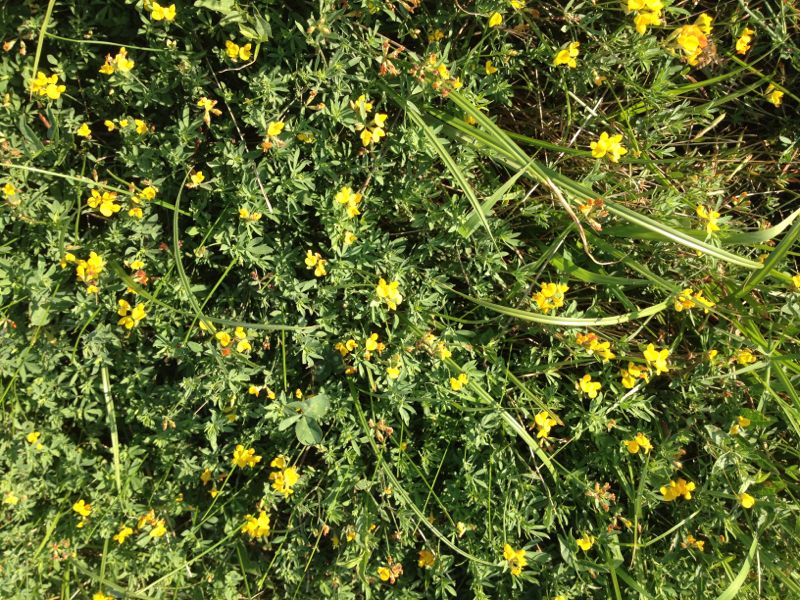 Here is what it looks like where it was irrigated.
Here is what it looks like where it was irrigated.
And here is a view of a paddock that has had plenty of water, has a manageable amount of dallisgrass,and hasn't been grazed for a few weeks.
This is self-portrait of the irrigator.
Farm Field Trip
/Today I hosted a field trip for 24 six and seven-year-olds and their accompanying adults. Thanks to the Farm Club for helping me out yet again. Kathy, Dona, Mary, and Maggie (Mary's daughter) all helped with the kids. We split into two groups for petting animals, learning the differences between hay and straw, sorting "sheep" in the chute (with shoe-laces, without shoe laces), etc. I don't have many photos because we were busy with the kids but I caught a few.
I always ask the kids if they think I have crayons in the barn. They say "no" and then I show them my crayons.
Kathy demonstrated how we use crayons.
The demo turned into the farm version of face-painting.
After the groups got back together, Rusty showed how he works sheep.
 Then the kids watched us demonstrate carding, spinning, and dyeing. We read a story, gave them all a postcard with Rusty's photo and they got back on their bus. Us adults retreated to the shop for de-briefing and visiting with the A/C going. Thanks Farm Club!
Then the kids watched us demonstrate carding, spinning, and dyeing. We read a story, gave them all a postcard with Rusty's photo and they got back on their bus. Us adults retreated to the shop for de-briefing and visiting with the A/C going. Thanks Farm Club!


